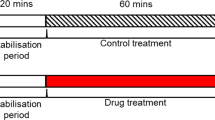Abtract
To obtain quantitative information about myocardial contractility in acute and chronic animal preparations during drug administration, a device for computing the ratio dp/dt: integrated isometric tension has been developed. Based on analogue computer techniques, the instrument samples ventricular pressure and the rate of change of ventricular pressure (dp/dt), during that phase of isovolumic contraction occurring before peak dp/dt. The isometric tension obtained is integrated and stored. The peak value of dp/dt is also stored. The two values are then simultaneously sampled, the division is performed by an analogue divider, and a 100 ms pulse whose height is proportional to the ratio (and thus myocardial contractility) is fed to a chart recorder. The R wave of the e.c.g. is used to start sampling of the ventricular pressure wave. A pulse derived from the peak dp/dt terminates sampling, and initiates resetting of the instrument ready for the next R wave. In this way, a beat-to-beat measure of myocardial contractility is obtained.
Sommaire
Un moyen a été développé pour évaluer la tension isométrique intégrée, rapport dp/dt pur obtenir des renseignements quantitatifs sur la contractilité myocardiale pour les préparations animales chroniques et aiguës durant l'administration de produits pharmaceutiques. Basé sur des techniques d'ordinateur analogue, l'instrument prélève la pression ventriculaire et le taux de changement de la pression ventriculaire (dp/dt) durant la phase de contraction isovolumique se produisant avant le sommet dp/dt. La tension isométrique obtenue est integrée et emmagasinée. La valeur maximum de dp/dt est aussi emmagasinée. Les deux valuers sont alors relevées simultanément, la division est exécutée par un diviseur analogue, et une pulsation de 100 ms dont la hauteur est proportionnelle au rapport (et ainsi la contractilité myocardiale) est envoyée dans un enregistreur. On se sert de l'onde R de l'e.c.g. pour mettre en marche le prélèvement des ondes de pression ventriculaire. Une pulsation derivée du maximum dp/dt met fin au prélèvement et amorce le rétablissement de l'instrument, prêt pour l'onde R suivante. De cette manière, on obtient une mesure, de la contractilité myocardiale d'un battement à l'autre.
Zusammenfassung
Man hat für die Bestimmung der quantitativen Auskunft über Herzmuskel-Zusammenziehbarkeit in akuten und chronischen tierischen Präparationen, während der Verabreichung von Drogen, eine Einrichtung für die Ausrechnung der Größe dp/dt integrierter isometrischen Spannung entwickelt. Mit der Verwendung der Analog-Computer Techniken nimmt das Instrument Proben des ventrikulären Druckes und der Wechselgeschwindigkeit des ventrikulären Druckes (dp/dt), während der Phase der isovolumischen Zusammenziehung bevor der dp/dt Spitze. Die isometrische Spannung dabei erreicht, wird integriert und gespeichert. Der Spitzenwert der dp/dt wird auch gespeichert. Proben der beiden Werte werden danach simultan genommen, die Teilung wird von einem Analog-Teiler unternommen und ein Impuls von 100 ms, dessen Amplitude proportional zum Verhältnis ist (und daher Herzmuskel-Zusammenziehbarkeit) wird an einen Streifenblattschreiber gespeist. Die R-Welle des EKG wird verwendet, um die Probennahme der ventrikuläre Druckwelle zu beginnen. Ein von der dp/dt Spitze abgeleiteter Impuls beendet die Probennahme und schaltet das Instrument auf die nächste R-Welle über. Auf diesem Wege, wird eine Schlag-zu-Schlag Abmessung der Herzmuskel-Zusammenziehbarkeit erzielt.
Similar content being viewed by others
References
Gersh, B. J., Hahn, C. E. andPrys-Roberts, C. (1971) Physical criteria for measurement of left ventricular pressure and its first derivative.Cardiovascular Research 5, 32–40.
Mason, D. T., Spann, J. F. Jr., Zelis, R. andAmsterdam, E. A. (1970) Alterations of hemodynamics and myocardial mechanics in patients with congestive heart failure.Progress in Cardiovascular Diseases 12, 507–557.
Siegel, J. H., Sonnenblick, E. H., Judge, R. D. andWilson, W. S. (1964) The quantification of myocardial contractility in dogs and man.Cardiologica 45, 189–220.
Siegel, J. H. (1969) The myocardial contractile state and its role in the response to anaesthesia and surgery.Anesthesiology 30, 519–564.
Sonneblick, E. H., Parmley, W. W., Urschel, C. W. andBrutsaert, D. L. (1970) Ventricular function: Evaluation of myocardial contractility in health and disease.Progress in Cardiovascular Disease 12, 449–466.
Zieske, H. A. andLevy, M. N. (1968) Cardiac contractility computer.J. Appl. Physiol. 24, 419–423.
Author information
Authors and Affiliations
Additional information
This paper is based on a paper given to the 9th ICMBE, Melbourne, Australia
Rights and permissions
About this article
Cite this article
Goodman, A.H., Angus, J.A., Einstein, R. et al. A device for measuring myocardial contractility. Med. & biol. Engng. 10, 483–495 (1972). https://doi.org/10.1007/BF02474196
Received:
Issue Date:
DOI: https://doi.org/10.1007/BF02474196




